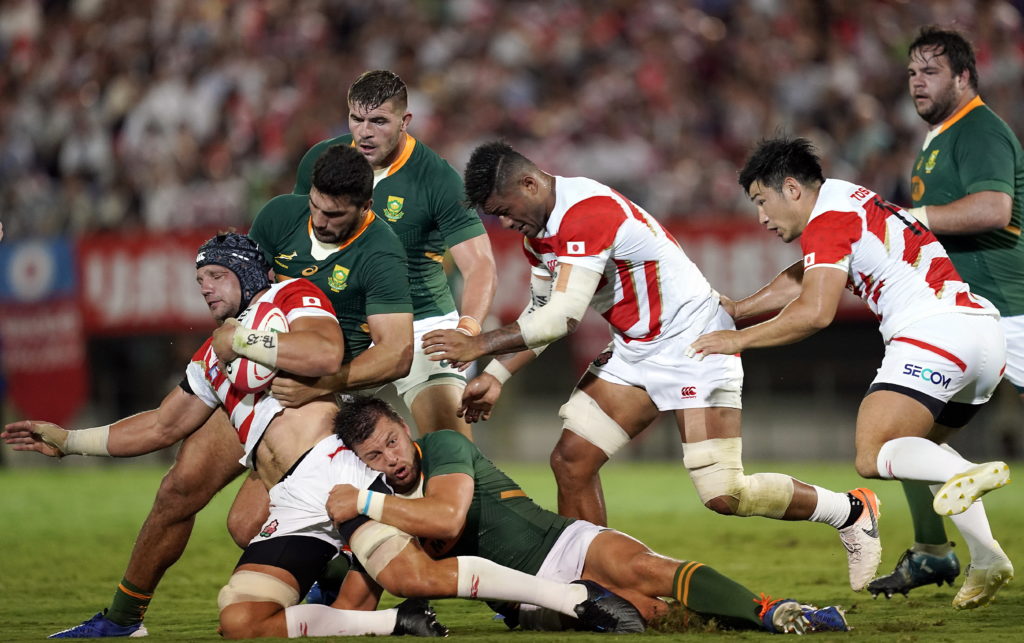Japan have been the most talked-about team at the Rugby World Cup after progressing to the quarter-finals as surprise winners of Pool A.
The hosts have played some great rugby to see off their group rivals Ireland and Scotland, while they have also gone about their business with a lot of heart and passion. It’s been a fantastic shot in the arm for the tournament, which seems to have suddenly woken up from its earlier slumber.
Japan’s attack has been on everybody’s lips. It’s been an intoxicating cocktail of intelligence, speed, patience and a lot of skill. This mix has left both Six Nations teams babelas, and they are hoping to cause the Springboks as much pain in Sunday’s blockbuster quarter-final.
ALSO READ: Form should dictate Bok selection
Japan’s attack is certainly something that have grabbed Bok coach Rassie Erasmus’ attention ahead of their meeting. The Bok coach is not someone who leaves anything to chance, and will be well prepared for anything the Japanese have to offer.
JOHN GOLIATH looks at five signs that Erasmus would have picked up in Japan’s wins over Ireland and Scotland ahead of Sunday’s match to help his team defeat the red-hot World Cup hosts.
Japan have an effective attacking breakdown strategy
For 50 minutes on Sunday Japan scrumhalf Yakuta Nagare was given the ball on a silver platter at the breakdown, where he used his snappy service to afford Japan front-foot ball to put pressure on the Scots with ball in hand. He made an incredible 75 passes during his playing time, most of them from quick ball from the base of the ruck.
Japan’s ball-carriers punch way above their weight with their beautiful body position in the carry, but it’s their effective cleanouts that give the Brave Blossoms the edge. They always seem to have two men on the ball-carrier’s shoulder, who protects the ball as soon as their mate is tackled. A ruck is formed as soon as these players engage the tackler and tackled player, which means the opposition can’t put hands in to compete for the ball.
These players sometimes also tend to clean out from the side, which is something Japan has got away with at this tournament. South African-born flank Lappies Labuschagne, who hits an enormous amount of rucks for the home side, has done it quite often while Japan also like to clean out past the ball and obstruct the opposition.
ALSO READ: Bongi may be Boks’ best bet
Attacking the blindside and operating in small spaces
Japan’s wingers are deadly predators who don’t need a lot of space to cause all sorts of havoc. Wings Kenki Fukuoka and Kotaro Matsushima are used many times on attack to see if they can use their speed and stepping ability to get in behind their opponents.
It’s going to be a fascinating battle between the Boks’ disruptive rush defence and Japan’s attack. In the first half against Scotland they relentlessly attacked that channel between outside centre and left wing, and found some space with simple draw-and-pass moves. Because their wings are so quick, they need just half a yard of space to beat their opponents.
But they are coming up against a team who doesn’t allow their opponents to get the ball out wide. Scotland were too passive and reactive on defence and were burned. The Boks, on the other hand, are out to smoke you. This means that Japan could decide to probe the blindside even more to try and suck in the Bok defenders, before changing direction and looking to create space for the wing on the far side.
WATCH: ‘Brighton loss has been erased’
Japan don’t have much of a kicking game, but …
Japan scrumhalf Nagare didn’t attempt a single kick in the first half. It really bucks the trend at this World Cup, as most of the big teams’ No 9s have tried to kick the leather off the ball.
Will Japan kick a lot more in a quarter-final? Maybe. Maybe not.
What we do know is the Boks are one of the teams who do most of their kicking from scrumhalf. The box kick is very much their primary method of attack, before the big ball-carriers such as Pieter-Steph du Toit, Duane Vermeulen and Damian de Allende are used as one-off runners in the vacuum to create some momentum.
If Japan kick, it’s likely to be off No 10 or inside centre to try to nullify the Boks’ rush defence with a little grubber or a kick over the top. Don’t be surprised if they also kick a few crosskicks, which the All Blacks employed in South Africa’s World Cup opener.
ALSO READ: Japan have been exceptional
Don’t maul much and love tail ball at lineout time
Japan’s lineout had mixed success against the Scots, as they preferred to gamble on the attacking ball at the back of the lineout rather than the banker ball at the front. Many of the balls were overthrown, and the ones that were caught went straight off the top to Nagare to feed the backline.
The tail ball is much more of a gamble against the Boks who will have a lot of tall timber in the pack. Pieter Steph du Toit will be guarding the back of the lineout for the Boks, while Erasmus also has four quality locks to choose from.
So, Japan will probably mix it up a lot more. They haven’t really used the maul at this World Cup, although they did surprise many four years ago by using it liberally in Brighton against the Boks. Variation in their lineout play could include the odd maul, but it may not be wise, because it’s unlikely that they will drive the South Africans backwards.
It’s suicide to attack the Boks from static ball, because their rush defence feed off flat-footed ball-carriers, and that’s something Japan will look to guard against.
Channel-one ball at the scrum is Japan’s bread and butter
Japan held their own in the scrum against Scotland, but they are going to struggle against the Boks. On their own ball, Japan take a quick heel and get the ball out of the oven as soon as possible. This could be their best way to attack the Boks’ narrow, rush defence and get the ball to the outside.
However, on South Africa’s put-in, they might struggle to contain the power of the Boks. This is where South Africa are likely to dominate the home side and earn penalties, which could lead to territorial advantage. The Boks would love nothing more than a stop-start game to prevent Japan from cutting loose and playing with width.
Photo: Steve Haag Sports via Hollywoodbets






